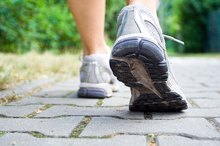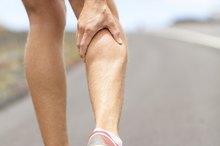Weak Leg Muscles From Sitting at a Desk Too Long
When you have a desk job, you do a lot of sitting in order to earn your paycheck. You're not alone — a 2013 study found that American adults sit an average of 13 hours a day, and that lack of standing and walking can have adverse effects on your health.
That includes having weak leg muscles, which can lead to back pain and other painful conditions. If you're a desk jockey, take measures to not only stand up and walk around regularly to get your blood circulating, but also to work your legs outside office hours to build up that weakened leg muscle.
Read more: 14 Exercises to Offset Sitting All Day
Lack of Muscle Use
Your muscles must be used in order to maintain strength and flexibility, and spending long hours at your desk can cause muscle fibers to break down. This is known as muscle atrophy and can make your leg muscles weak over time.
Additionally, the added pressure to the muscles on the back of your thighs, known as the hamstrings, can affect blood circulation, also leading to muscle breakdown.
You also may notice that your hamstrings feel tight after a long day of sitting at your desk; this can cause them to pull on your lower back and create back pain. Your iliopsoas muscles are those that connect from your thigh bone to your spine.
When you sit at your desk for long periods of time, the iliopsoas muscles are in a constant, flexed position. In this position, the muscles are shorter, which can pull on your spine more when you are standing, contributing to back pain and difficulty straightening your leg muscles after long periods of sitting.
For this reason, it’s important to take stand-and-stretch breaks throughout your day to keep the iliopsoas muscles from staying in a constant flexed position.
- Your muscles must be used in order to maintain strength and flexibility, and spending long hours at your desk can cause muscle fibers to break down.
- For this reason, it’s important to take stand-and-stretch breaks throughout your day to keep the iliopsoas muscles from staying in a constant flexed position.
Take Stretch Breaks
Stretches for Thigh Pain
Learn More
Becoming absorbed in your work can make it difficult for you to take regular stretch breaks throughout the course of your workday. You can set an alarm on your computer or phone to remind you to get up and stretch every hour you are at work.
Some stretches include standing up and placing your hands on your lower back, leaning backward and arching your back. You also can circle your shoulders and pull one knee toward your chest at a time to stretch your legs and lower back. Walking up and down a few flights of stairs also can activate your leg muscles.
- Becoming absorbed in your work can make it difficult for you to take regular stretch breaks throughout the course of your workday.
- You can set an alarm on your computer or phone to remind you to get up and stretch every hour you are at work.
Fix Your Ergonomics
Because you can’t change the fact that you work at a desk, ensure your chair and computer are at the best position to minimize leg muscle pain. Your feet should sit flat on the floor, and your back should be able to touch the back of your chair so the chair cushions your back. The seat of your chair should not dig into the backs of your legs, which can affect leg muscle circulation.
If you have the opportunity, ask your office manager or human resources professional if you can switch to an ergonomically friendly chair or bring in an exercise ball to sit on. Additionally, standing desks, including those that slide up and down, have become much more financially feasible.
Read More: Discreet Exercises You Can Do Sitting in a Chair
- Because you can’t change the fact that you work at a desk, ensure your chair and computer are at the best position to minimize leg muscle pain.
Work Out Outside the Office
Muscles Used in Hip Extension
Learn More
When you're not sitting at your desk, schedule regular strength exercises to build your leg muscle and reverse the effects of lack of movement. You don't need fancy weights or a gym; simply do regular bodyweight exercises, such as:
Related Articles
References
- Sports Injury Clinic: Back Pain and Posture
- JustStand.org: The Facts: Sit-Stand Basics
- Dunstan DW, Kingwell BA, Larsen R, Healy GN, Cerin E, Hamilton MT, Shaw JE, Bertovic DA, Zimmet PZ, Salmon J, Owen N. "Breaking up prolonged sitting reduces postprandial glucose and insulin responses." Diabetes Care. 2012 Feb 28. doi:10.2337/dc11-1931
- Bailey DP, Locke CD. "Breaking up prolonged sitting with light-intensity walking improves postprandial glycemia, but breaking up sitting with standing does not." J Sci Med Sport. 2014 Mar 20. pii: S1440-2440(14)00051-6. doi:10.1016/j.jsams.2014.03.008.
- Thosar SS, Bielko SL, Mather KJ, Johnston JD, Wallace JP. "Effect of prolonged sitting and breaks in sitting time on endothelial function." Medicine and Science in Sports and Exercise. 2014 Aug 18. doi:10.1249/MSS.0000000000000479
- Koepp GA, Manohar CU, McCrady-Spitzer SK, Ben-Ner A, Hamann DJ, Runge CF, Levine JA. "Treadmill desks: A 1-year prospective trial." Obesity (Silver Spring) 2013 Apr;21(4):705-11. doi:10.1002/oby.20121.
- Carr L, Leonhard C, Tucker S, Fethke N, Benzo R, Gerr F. "Total worker health intervention increases activity of sedentary workers."Preventive Medicine. August 07, 2015. doi:10.1016/j.amepre.2015.06.022.
- Levine JA, Miller JM. "The energy expenditure of using a 'walk-and-work' desk for office workers with obesity" British Journal of Sports Medicine 2007;000:1-4. doi: 10.1136/bjsm.2006.032755
- Aviroop Biswas, BSc; Paul I. Oh, MD, MSc; Guy E. Faulkner, PhD; Ravi R. Bajaj, MD; Michael A. Silver, BSc; Marc S. Mitchell, MSc; and David A. Alter, MD, PhD "Sedentary Time and Its Association With Risk for Disease Incidence, Mortality, and Hospitalization in Adults: A Systematic Review and Meta-analysis", Annals of Internal Medicine, V 2015;162(2):123-132. doi:10.7326/M14-1651.
Writer Bio
Rachel Nall began writing in 2003. She is a former managing editor for custom health publications, including physician journals. She has written for The Associated Press and "Jezebel," "Charleston," "Chatter" and "Reach" magazines. Nall is currently pursuing her Bachelor of Science in Nursing at the University of Tennessee.





